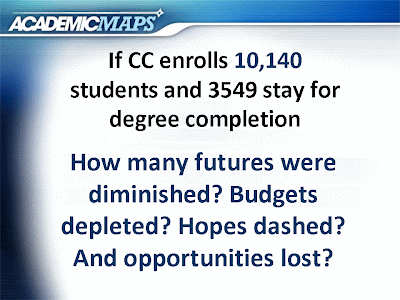
According to a recent report entitled College Enrollment Hits All-Time High, Fueled by Community College Surge by Richard Fry, Senior Research Associate,
Isn’t that great?
Nah. Not really.
Well, not necessarily. As usual we have jumped on the bandwagon of the number enrolled students in the Fall and how many more have started college this year over last. We focus on the incoming numbers at the start of the game. But are not looking where we really need to look. The win-loss column. Graduation.
Higher education is too often like the losing coach of a football team. “We played a great first quarter. Started off well. Put up some numbers but just couldn’t hold them.” The first quarter does not decide the game. The final score does. In football, it is how many time a team puts the ball over the goal line or through the uprights. For a college, it is how many students cross the stage and receive a certificate or diploma.
It does not matter how many start college. It does matter how many finish it. And if you look at our ending scores, it is almost sad that so many people are starting college.
If they start in a four year college, only 50.6% will cross the finish line in six, yes six years. Right, the game is supposed to have four quarters but to try and show some success, we now allow the four quarters/semesters to run for six years before we call the game over. Even so the number is dismal. Only 50.6% will cross the goal line in that extended period.
So with 8,041,000 students enrolled in four year schools, only 4,068,746 may succeed in six years of attendance.
For two-year colleges where the greatest enrollment grown occurred, the number is even worse. According to NCHEMS, the national three-year graduation rate in two-year associate degree colleges was 27.8% in 2007. That percentage is pretty consistent over the years by the way. Or to make sure we all get the full impact,72.2% of all students that started at a two-year college DID NOT GRADUATE !

Considering that the conclusion of the Pew Center study was that almost all the enrollment growth was in two-year colleges, this means that of the 305,000 additional students, if the percentages hold, 220,210 will have dropped out, stopped out, flunked out, failed or whatever phrase one wants to use for not graduated - not succeeded.
Consider that the average community college costs students $6,750 per year including all costs according to the College Board as quoted in the Pew Trust report. The net price to students includes published tuition, fees, room and board minus grant aid. The average Pell Grant according the Federal government was $2,770, That leaves an average net out of pocket cost for community college students of at least $3,980. With books, transportation and miscellaneous costs it easily exceeds $4,000 out-of-pocket. Net cost times the average projected number of drops leads to a collective financial loss of $88,080,000 from these students' attrition.
That’s a big dollar number but it really only represents the lost millions from the current increase in enrollment. It does not speak to the pre-existing base of students which is also going to incur the 72.2% attrition prior to graduation. Students drop out during every term/semester of every year. It is not just a first year phenomena as most school's numbers would have one think. We normally publish the first to second year attrition rate which is why it seems so small in comparison to the reality.
To bring it home with a specific example, I have placed some slides from a presentation at a community college at which I spoke recently. Figures are based on its approximately 35% graduation rate.
So the point here is that it does not matter how many more students are enrolled to begin with if a college is losing 65-72.2% of all of them. Of course, we can all argue that the numbers are wrong. After all, some students come to a college just to try, to taste college and see if it is for them. And others just stay a year, accomplish what they wanted to and leave. Yet others, like Mary Kay took eight years to complete her two year program but she will be done with her bachelor's in just seven. There are numerous anecdotal anomalies and traditional excuses but the research numbers have already encountered and considered them. We should all do the same and not look for excuses but for solutions. The fact is that more students leave college than succeed in it.
In fact, if community colleges continue to lose 72.2% of their initial cohorts over three years and four-year schools lose 49.4% of all their students in six years, it is not necessarily good news at all that more students are starting. It can be seen as quite sad news since so many millions of lives will be hurt through dropping out and failing at college. Moreover, those drops also mean that family wealth and the growth of our economy drops with them. Students who leave college without graduating have absolutely nothing to show for it. Except months or years wasted in pursuit of a better future. Their return on investment is a negative.
Society’s ROI is a negative also. Consider that the Pell Grants of $2,770 for the average community college student and four-year degree students comes out of tax revenue. We are paying out taxes that are being wasted. Think of that the next time you drive by a college. Wasted not by the students but by the schools who accept the students and do not provide the academic customer service that could keep an additional 84% of these drops in school to graduate. Or by schools that suffer from enrollment ethical deficit syndrome and enroll students they know will either not make it, or only succeed with a great deal of assistance but do not provide it because it is too costly.
It is time for us to stop congratulating ourselves on the increased number of students entering college and start celebrating and demanding an increased number of students graduating. It is through crossing the goal line and graduating that students, society and the economy really succeed.If there are any questions you might have after reading this, I will get back as soon as I can but it may be a couple of days after the posting since I am having some knee surgery. Already had my heart cut out when I was a college president.
 AcademicMAPS is the leader in increasing student retention, enrollment and revenue through research training and customer service solutions to colleges, universities and career colleges in the US, Canada, and Europe as well as to businesses that seek to work with them
AcademicMAPS is the leader in increasing student retention, enrollment and revenue through research training and customer service solutions to colleges, universities and career colleges in the US, Canada, and Europe as well as to businesses that seek to work with them TO INCREASE YOUR SCHOOL'S RETENTION
www.GreatServiceMatters.com
info@GreatServiceMatters.com
413.219.6939
“We had hoped we’d improve our retention by 3% but with the help of Dr. Raisman, we increased it by 5%.” Rachel Albert, Provost, University of Maine-Farmington
“Neal led a retreat that initiated customer service and retention as a real focus for us and gave us a clear plan. Then he followed up with presentations and workshops that kicked us all into high gear. We recommend with no reservations; just success.” Susan Mesheau, Executive Director U First: Integrated Recruitment & Retention University of New Brunswick
“Thank you so much for the wonderful workshop at Lincoln Technical Institute. It served to re-center ideas in a great way. I perceived it to be a morale booster, breath of fresh air, and a burst of passion.” Shelly S, Lincoln Technical Institute





















No comments:
Post a Comment